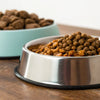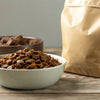Understanding Why Dogs Stop Eating Dry Food: Causes and Solutions
- Houndsy
Table of Contents
- Introduction
- Common Causes of Appetite Changes in Dogs
- Assessing Your Dog’s Eating Habits
- Solutions to Encourage Eating
- When to Seek Veterinary Help
- Conclusion
Introduction
Did you know that up to 20% of dog owners report their pets refusing to eat dry food at some point? This common concern can leave us feeling anxious and puzzled. As devoted pet parents, we want to ensure our furry companions are happy and healthy, and a sudden aversion to their regular kibble can spark a series of worries. Understanding why dogs stop eating dry food is crucial for maintaining their well-being and ensuring they receive adequate nutrition.
In this blog post, we will explore the various reasons why dogs may refuse their dry food, ranging from health issues to behavioral changes. We’ll provide actionable insights to help you identify the underlying causes and what steps you can take to encourage your pup to eat again. By the end of this article, you will have a comprehensive understanding of the factors that influence your dog’s eating habits, empowering you to make informed decisions about their diet and care.
We encourage you to reflect on your own pet’s feeding routine as we delve into this topic. Are there recent changes in their behavior or eating habits? Let’s embark on this journey together to uncover the answers to why our canine companions might be turning their noses up at dry food.
Common Causes of Appetite Changes in Dogs
Health-Related Issues
Dogs, like us, can experience a myriad of health problems that affect their appetite. Here are some common medical reasons that might explain why your dog is avoiding dry food.
1. Dental Problems
Oral health plays a significant role in your dog’s eating habits. Issues like periodontal disease, tooth decay, and oral injuries can cause pain when chewing dry kibble. If your dog seems hesitant to eat or only nibbles at their food, it could be a sign of dental discomfort. Regular dental check-ups and maintaining oral hygiene can help prevent these issues.
2. Gastrointestinal Distress
Nausea, upset stomach, or other gastrointestinal issues can lead to a sudden refusal to eat dry food. Conditions such as pancreatitis or gastroenteritis can cause discomfort, making your dog prefer softer, more palatable options. If the refusal to eat is accompanied by vomiting, diarrhea, or lethargy, it’s essential to consult your veterinarian promptly.
3. Dehydration
A dehydrated dog may lose interest in food altogether. Signs of dehydration can include dry gums, excessive panting, and lethargy. Ensuring that your dog has access to fresh water at all times can help maintain hydration levels and encourage eating.
Behavioral Factors
Sometimes, the reasons behind a dog’s refusal to eat dry food are behavioral rather than health-related.
1. Stress and Anxiety
Changes in the household, new pets, loud noises, or even changes in routine can create stress for our dogs, leading to a decreased appetite. If your dog displays signs of anxiety, such as pacing or hiding, it may be worthwhile to create a calm feeding environment to help them feel more secure.
2. Kibble Fatigue
Just like us, dogs can get bored with their food. If your pup has been eating the same dry food for an extended period, they may lose interest. Rotating flavors or introducing food toppers can help reignite their enthusiasm for mealtime.
3. Picky Eating Habits
Some dogs are naturally more finicky than others. They may refuse dry food simply because they prefer the taste or texture of wet food or treats. If your dog is a picky eater, experimenting with different brands or food types can make a significant difference.
Assessing Your Dog’s Eating Habits
Observational Techniques
If your dog has stopped eating dry food, it’s essential to observe their behavior closely. Here are some techniques to help you assess their eating habits:
- Monitor Portion Sizes: Take note of how much your dog is eating over time. Are they consuming fewer portions, or has their appetite changed dramatically?
- Check Their Bowls: Ensure that their food and water bowls are clean and free from any foul odors. Sometimes, a dirty bowl can deter dogs from eating.
- Inspect for Signs of Illness: Look for symptoms such as vomiting, diarrhea, or lethargy. If your dog exhibits any unusual behavior, it may warrant a visit to the vet.
Engaging with Your Dog
Sometimes, a little engagement can spark a dog’s interest in their food. Here are some strategies to encourage your dog to eat:
- Hand Feeding: For some dogs, hand feeding can create a sense of intimacy and make mealtime more appealing.
- Interactive Feeding: Using puzzle feeders or snuffle mats can turn feeding time into a fun activity, encouraging your dog to engage with their food.
Solutions to Encourage Eating
Food Modifications
If your dog is refusing dry food, consider making some adjustments to their meals:
1. Enhance Flavor
Adding a small amount of wet food, broth, or even warm water to dry kibble can make it more enticing. The added moisture can enhance the aroma and flavor, encouraging your dog to dig in.
2. Switch Up the Brand
Not all kibble is created equal. If your dog consistently refuses a specific brand, it may be worth trying a different formulation or flavor. Higher quality dog food may also yield better results.
3. Use Food Toppers
Consider introducing healthy food toppers, such as plain yogurt, pumpkin, or cooked vegetables, to make their meals more exciting. These additions can provide nutritional benefits while enticing your dog to eat.
Behavioral Adjustments
Addressing behavioral issues can also help encourage your dog to eat:
1. Create a Calm Eating Environment
Designate a quiet, comfortable space for your dog to eat, away from distractions and commotion. This can help reduce anxiety during mealtime.
2. Stick to a Routine
Dogs thrive on routine. By consistently feeding them at the same times each day, you can help establish a sense of stability that may encourage better eating habits.
When to Seek Veterinary Help
If your dog refuses to eat dry food for more than 24 hours or exhibits any concerning symptoms, it’s essential to consult with your veterinarian. They can perform a thorough examination and possibly run diagnostic tests to identify any underlying health issues.
Conclusion
Understanding why dogs stop eating dry food is vital for their health and happiness. By recognizing the potential health and behavioral factors that contribute to this issue, we can take proactive steps to ensure our furry friends receive the nutrition they need.
From dental health to hydration, behavioral adjustments to dietary modifications, there are numerous ways we can encourage our dogs to embrace their kibble once again. If you find yourself struggling with your dog’s feeding habits, remember that you are not alone.
For those looking to elevate their dog feeding experience, we invite you to explore the Houndsy Kibble Dispenser. Designed with convenience and aesthetics in mind, this innovative product makes feeding time a beautiful and enjoyable ritual. Visit our product page to learn more about how the Houndsy Kibble Dispenser can transform your dog's feeding experience Order Now.
FAQ
Why has my dog suddenly stopped eating dry food?
There are many potential reasons, including dental issues, gastrointestinal distress, or behavioral changes such as stress or boredom with their food. Observing your dog’s behavior and consulting with a veterinarian can help identify the cause.
What should I do if my dog won't eat for more than a day?
If your dog refuses to eat for more than 24 hours, especially if accompanied by other symptoms like vomiting or lethargy, it’s crucial to consult your veterinarian for an evaluation.
Can I mix wet food with dry food?
Absolutely! Mixing wet food with dry kibble can enhance the flavor and aroma, making it more appealing to your dog. Just ensure that the diet remains balanced and meets their nutritional needs.
How can I tell if my dog is dehydrated?
Signs of dehydration include dry gums, lethargy, excessive panting, and skin that doesn’t bounce back when gently pinched. Always ensure your dog has access to clean, fresh water.
Is it normal for dogs to be picky eaters?
Yes, some dogs have particular preferences and may be more selective about their food. Experimenting with different brands or types of food can help find what they enjoy.













